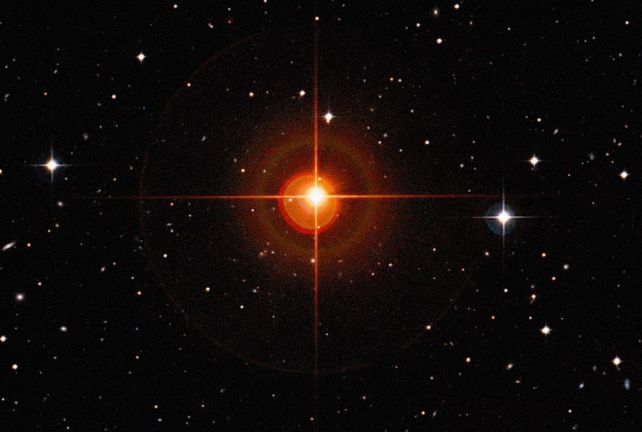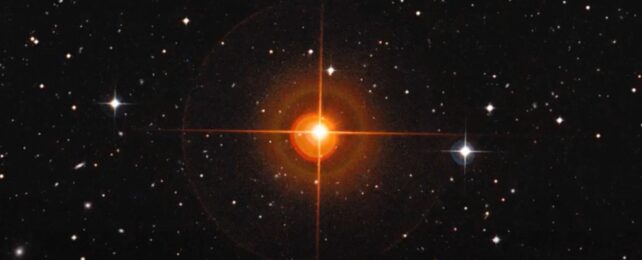A rather unusual candidate for dark matter could be lurking inside stars, slowly eating them from the inside out.
A new paper led by astrophysicist Earl Bellinger of the Max Planck Institute for Astrophysics and Yale University proposes that teeny tiny black holes that formed at the dawn of time could have been incorporated into Sun-like stars, and have been sitting at their cores ever since, gradually slurping up material and turning it into more black hole.
It's all extremely hypothetical, of course. But the study examines the effect such parasitism would have on these stars, and how we could recognize them out there in the Universe, should we happen across them.
"We find that such objects can be surprisingly long-lived, with the lightest black holes having no influence over stellar evolution, while more massive ones consume the star over time to produce a range of observable consequences," the researchers write in their paper.
"The unique internal structures of stars harboring black holes may make it possible for asteroseismology to discover them, should they exist."

The Universe is full of black holes across a range of sizes. We've seen black holes with stellar mass ranges, that likely formed from the core collapse of a massive star at the end of its life, and the mergers thereof. There are supermassive monsters, millions to billions of times the mass of the Sun, lurking at the heart of every galaxy. And there are black holes with masses in between, elusive but emerging in increasing numbers.
What we haven't found are really tiny black holes – those with masses similar to planets, moons, or asteroids. These objects don't have enough mass and therefore gravity to collapse into something as dense as a black hole.
But there is a way that tiny black holes could have formed, theoretically.
According to theory developed by Stephen Hawking in the 1970s and expanded by other scientists since, itty-bitty black holes could have formed in the first second or so after the Big Bang, when the matter in the Universe was still hot and dense enough that patches of extra density could have collapsed into inescapable patches of spacetime.
Where these 'primordial' black holes went – if they ever existed – is a mystery, but they'd be a tidy explanation for the extra gravity in the Universe we attribute to dark matter.
Some scientists think they could have ended up inside neutron stars, sitting in the cores and just munching away like some weird cosmic tapeworm.
Bellinger and his colleagues wanted to investigate the possibility of an endoparasitic black hole, not in a dead stellar remnant like a neutron star, but a living, fusing, main-sequence star like the Sun. Hawking himself proposed that the Sun could be harboring a primordial black hole. Other scientists have performed theoretical analyses, and determined that a primordial black hole would devour a star from within.
For their own analysis, Bellinger and his team calculated what would happen to a star ranging between 0.8 and 100 solar masses forming around a primordial black hole up to the mass of a star. They also conducted the first full numerical evolutionary simulations of Sun-like stars with primordial black holes lurking in their cores.
The very smallest black holes, the researchers found, would have a difficult time growing. It would take billions of years for the black hole to consume the star.
But a black hole with the mass of a dwarf planet would be much more voracious. It would start to consume the core of a Sun-like star, material roiling around it into a disk that starts to produce huge amounts of light and heat.
Within a billion years, fusion would no longer be powering the star; instead, this star would be powered by the accretion disk churning around the black hole. All the star's light would – ironically perhaps – be produced by the black hole. The researchers have named this hypothetical type of star a Hawking star.

A Hawking star would behave fairly similarly to a normal star, with a few key differences. Its outer layers would puff up into a red giant, just like the Sun is expected to do when fusion starts to die down at the end of its life. But it would be cooler in temperature than we might expect such a star to be. Interestingly, we've already found anomalously cool red giant stars in the Milky Way. They're called red stragglers.
We could, the researchers say, study these stars to look for the signatures of a black hole engine. Black hole accretion is expected to produce different acoustic patterns inside the star than fusion, which could be detectable as minute changes in brightness on the star's surface. What the brightness changes look like is not known at this point; the researchers aim to tackle that question in a future paper.
"This presents an opportunity to either discover such objects, or to place bounds on their number and capture rate," the researchers write.
"The implications for stars in more advanced evolutionary stages, numerical results for stars of different masses and metallicities, and investigations into stellar populations will also be explored in future works."
The research has been published in The Astrophysical Journal.
